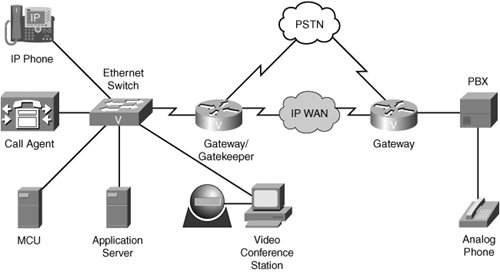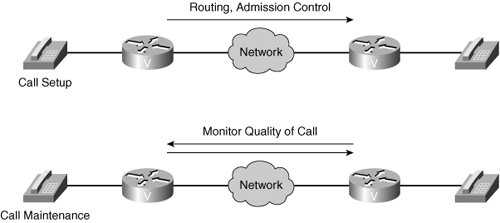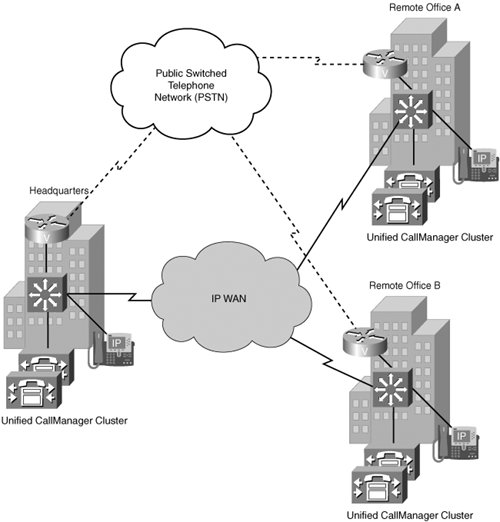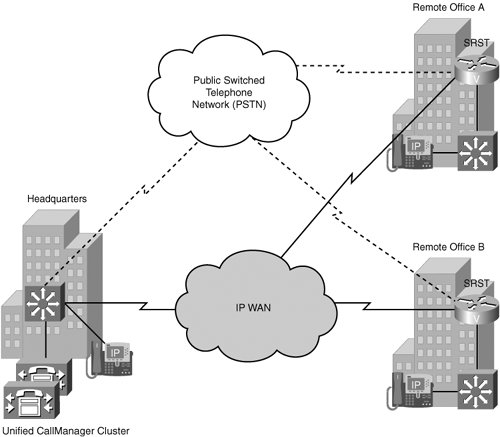| The increased efficiency of packet networks (for example, VoIP networks) and the ability to statistically multiplex voice traffic with data packets allows companies to maximize their return on investment (ROI) in data network infrastructures. Multiplexing voice traffic with data traffic reduces the number of costly circuits dedicated to servicing voice applications. As demand for voice services expands, it is important to understand the different requirements of voice and data traffic. Previously, voice and data networks were separate and could not impact each other. Today, it is necessary to determine the protocols available to control voice calls and ensure that data flows are not negatively impacted. This section delves into the benefits of packet telephony networks and provides an overview of basic packet telephony operations. Additionally, the fundamental components of packet networks are introduced. Finally, as a design consideration, this section considers the fragile nature of voice packets. Benefits of Packet Telephony Networks Traditionally, the potential savings on long-distance costs was the driving force behind the migration to converged voice and data networks. However, as the cost of long-distance calls has dropped in recent years, other factors have come to the forefront as benefits of converged networks. The benefits of packet telephony versus circuit-switched telephony are as follows: More efficient use of bandwidth and equipment Traditional telephony networks use a 64-kbps channel for every voice call. Packet telephony shares bandwidth among multiple logical connections and offloads traffic volume from existing voice switches. Lower costs for telephony network transmission A substantial amount of equipment is needed to combine 64-kbps channels into high-speed links for transport across the network. Packet telephony statistically multiplexes voice traffic alongside data traffic. This consolidation represents substantial savings on capital equipment and operations costs. Consolidated voice and data network expenses Data networks that function as separate networks to voice networks become major traffic carriers. The underlying voice networks are converted to utilize the packet-switched architecture to create a single integrated communications network with a common switching and transmission system. Increased revenues from new services Packet telephony enables new integrated services, such as broadcast quality audio, unified messaging, and real-time voice and data collaboration. These services increase employee productivity and profit margins well above those of basic voice services. In addition, these services enable companies and service providers to differentiate themselves and improve their market position. Greater innovation in services Unified communications use the IP infrastructure to consolidate communication methods that were previously independent; for example, fax, voice mail, e-mail, wireline telephones, cellular telephones, and the Web. The IP infrastructure provides users with a common method to access messages and initiate real-time communications, independent of time, location, or device. Access to new communications devices Packet technology can reach devices that are largely inaccessible to the TDM infrastructures of today. Examples of such devices are computers, wireless devices, household appliances, personal digital assistants (PDAs), and cable set-top boxes. Intelligent access to such devices enables companies and service providers to increase the volume of communications they deliver, the breadth of services they offer, and the number of subscribers they serve. Packet technology, therefore, enables companies to market new devices, including videophones, multimedia terminals, and advanced IP phones. Flexible new pricing structures Companies and service providers with packet-switched networks can transform their service and pricing models. Because network bandwidth can be dynamically allocated, network usage no longer needs to be measured in minutes or distance. Dynamic allocation gives service providers the flexibility to meet the needs of their customers in ways that bring them the greatest benefits.
Although packet technology has clear benefits, you should carefully consider the following points before migrating to this technology: ROI, when based on the new system features, can be difficult to prove. Generally, voice and data staffs use different terminology to describe the network. Current voice telephony components have not yet fully depreciated. Potential upgrade costs will override potential savings benefits.
Packet Telephony Components The basic components of a packet voice network, as shown in Figure 1-12, include the following: IP phones Provide IP voice to the desktop. Gatekeeper Provides Call Admission Control (CAC), bandwidth control and management, address translation, and call routing. Gateway Provides translation between VoIP and non-VoIP networks, such as the PSTN. It also provides physical access for local analog and digital voice devices, such as telephones, fax machines, key sets, and PBXs. Multipoint control unit (MCU) Provides real-time connectivity for participants in multiple locations to attend the same videoconference or meeting. Call agent Provides call control for IP phones, CAC, bandwidth control and management, and address translation. The call agent also serves as a repository for call routing information. Application servers Provide services such as voice mail, unified messaging, or call center support. Videoconference station Provides access for end-user participation in videoconferencing. The videoconference station contains a video capture device for video input and a microphone for audio input. The user can view video streams and hear the audio that originates at a remote user station. Cisco targets its VT Advantage product at desktop videoconferencing applications.
Figure 1-12. Packet Telephony Network Components 
Other components, such as software voice applications, interactive voice response (IVR) systems, and softphones, provide additional services to meet the needs of enterprise sites. Call Control Call control allows users to establish, maintain, and disconnect a voice flow across a network, as shown in Figure 1-13. Figure 1-13. Call Control 
Although different protocols address call control in different ways, they all provide a common set of services. The following are the basic components of call control: Call setup Checks call-routing configuration to determine the destination of a call. The configuration specifies the bandwidth requirements for the call. When the bandwidth requirements are known, CAC determines if sufficient bandwidth is available to support the call. If bandwidth is available, call setup generates a setup message and sends it to the destination. If bandwidth is not available, call setup notifies the initiator by presenting a busy signal. Different call control protocols, such as H.323, Media Gateway Control Protocol (MGCP), and Session Initiation Protocol (SIP), define different sets of messages to be exchanged during setup. Call maintenance Tracks packet count, packet loss, and interarrival jitter, or delay, when the call is set up. Information passes to the voice-enabled devices to determine if connection quality is good or if it has deteriorated to the point where the call should be dropped. Call teardown Notifies voice-enabled devices to free resources and make them available for the next call when either side terminates a call.
From a design perspective, you can set up call control in either a distributed or centralized architecture. The following sections describe both types. Distributed Call Control Distributed call control, an example of which is shown in Figure 1-13, offers an environment where call control is handled by multiple components in the network. This approach to call control is possible where the voice-capable device is configured to support call control directly. This is the case with a voice gateway when protocols, such as H.323 or SIP, are enabled on the device. In Figure 1-14, each location contains a Cisco Unified CallManager cluster. Each cluster is capable of handling call processing. Therefore, the topology shown demonstrates one example of distributed call control. Figure 1-14. Distributed Call Control 
Distributed call control enables the gateway to perform the following procedure: 1. | Recognize the request for service
| 2. | Process dialed digits
| 3. | Route the call
| 4. | Supervise the call
| 5. | Terminate the call
|
Centralized Call Control Centralized call control, an example of which is illustrated in Figure 1-15, allows an external device (call agent) to handle the signaling and call processing, leaving the gateway to translate audio signals into voice packets after call setup. The call agent is responsible for all aspects of signaling, thus instructing the gateways to send specific signals at specific times. Also, the centralized call control model can leverage Cisco's Survivable Remote Site Telephony (SRST) feature to provide redundancy in the event of a WAN outage by having the voice-enabled router at the remote site perform basic call processing functions. In the figure, a Cisco Unified CallManager cluster located at the Headquarters location is in charge of call control. Therefore, the topology shown demonstrates an example of centralized call control. Figure 1-15. Centralized Call Control 
When the call is set up, the following occur: The voice path runs directly between the two gateways and does not involve the call agent. When either side terminates the call, the call agent signals the gateways to release resources and wait for another call.
The use of centralized call control devices is beneficial in several ways: It centralizes the configuration for call routing and CAC. In a large voice environment, centralization can be extremely beneficial. The call agent is the only device that needs the intelligence to understand and participate in call control functions. These call control functions enable the customer to purchase less expensive voice-gateway devices and point to a single device to handle call control.
MGCP is one example of a centralized call control model. Real-Time Versus Best-Effort Traffic Voice and data can share the same medium. However, their traffic characteristics differ widely: Voice is real-time traffic and data is typically sent as best-effort traffic. Traditional telephony networks were designed for real-time voice transmission, and therefore they cater to the need for a constant voice flow over the connection. Resources are reserved end to end on a per-call basis and are not released until the call is terminated. These resources guarantee that voice flows in an orderly manner. Good voice quality depends on the capacity of the network to deliver voice with guaranteed delay and timing. Traditional data networks were designed for best-effort packet transmission. Packet telephony networks transmit with no guarantee of delivery, delay, or timing. Data handling is effective in this scenario because upper-layer protocols, such as TCP, provide for reliable, although untimely, packet transmission. TCP trades delay for reliability. Data can typically tolerate a certain amount of delay and is not affected by interpacket jitter. A well-engineered, end-to-end network is required when converging delay-sensitive traffic, such as VoIP, with best-effort data traffic. Fine-tuning the network to adequately support VoIP involves a series of protocols and features to improve quality of service (QoS). Because the IP network is, by default, best effort, steps must be taken to ensure proper behavior of both the real-time and best-effort traffic. Packet telephony networks succeed, in large part, based on the QoS parameters that are implemented network-wide. |



